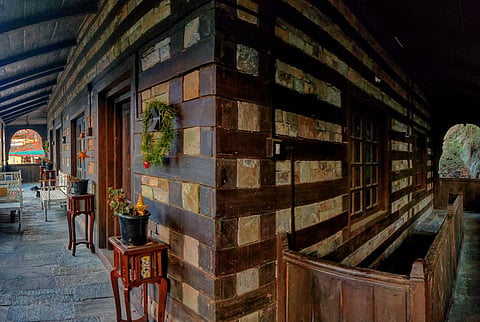

India is a country of rich traditions that have evolved and have been passed down generations. But we are losing our age-old heritage, one craft at a time. Rahul Bhushan, a 29-year-old from Himachal Pradesh, came up with a one-of-a-kind platform to sustain the crafts, heritage and cultural ecology of the Himalayas. NORTH was born in 2017 after Rahul went back to Himachal after finishing his postgraduation with a specialisation in crafts and technology from CEPT University in Ahmedabad.
Rahul set up the NORTH campus at Naggar in Kullu to promote the traditional crafts and architecture of the region. It offers inter-disciplinary artist residencies, sustainable ways of living and also, gives you a space to be one with nature. It all started with Rahul's love for the traditional architecture of the Himalayas — Kath-Kuni — which uses interlocked wooden panels and stone to build structures. This is also found in Istanbul, Switzerland and even Japan. What is amazing is that no concrete or binding agent is used, yet the houses are earthquake resistant. "India, especially this region, was exposed to a lot of different cultures and practices as it was a part of the Silk Route. Along with trade, which was the main motive, various cultural and livelihood practices were also exchanged. Another hypothesis, a more convincing one, says that the locals indigenously experimented with materials and since the landscape or issues like earthquakes were common in these regions, the architecture too evolved to become similar. Not just Istanbul and Switzerland, Vikings also have similar structures. The timeline of the Vikings match that of the Himachal region as well," said Rahul.
Rahul has grown up all across Himachal and the varied architecture intrigued him from childhood. "I completed my BArch from National Institute of Technology, Hamirpur and then went to CEPT University to pursue a postgraduation in Crafts and Architecture. My thesis was on indigenous building practices in Western Himalayan ranges," said Rahul who is in the process of publishing his thesis in the form of a book. "I worked on a comparative analysis of the architectural styles of Jammu and Kashmir, Himachal Pradesh and Uttarakhand. While I was working on it, I had made up my mind to work more in this field and apply it on-ground as well. I wanted to start a centre in Himachal. The idea was to have a space where artists who practice various artforms could collaborate and build something unique and breathtaking," he added.
During our conversation, I learnt that Kath-Kuni cannot be looked at as a singular architectural form — it is a mix of various crafts. "I see this as art and not a construction. There's wood carving, stone art, wood joinery, metal art and even more," said Rahul. "Right after finishing my thesis, I came right back with the intention of taking up projects to restore the architecture. I started visiting government offices to show them my work and ask if there was any department that could do with some restoration. The Forest Department gave me four forest ranger bungalows — made with a mix of British and local architecture — in Naggar to restore. I started restoring the buildings and organically landscaping the attached forest area. I started hosting artist residencies there as well. My deal with the Forest Department was that I would restore it with my own funds and I could conduct workshops there. We also restored the Naggar Castle. I made a report for them on eco-tourism. I suggested that they could add art interactions and study programmes as part of the tourism package. People want to experience the traditional way of living rather than living in a concrete house," said Rahul.
